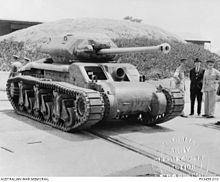AC4 tank
| Australian Cruiser Tank Mk. 4 | |
|---|---|
![[An AC4 tank illustration.]](http://upload.wikimedia.org/wikipedia/commons/thumb/8/86/AustralianCruiserTankMkIV.jpg/300px-AustralianCruiserTankMkIV.jpg) A 1943 artist's illustration of the AC MkIV tank based on the production drawings | |
| Type | Cruiser tank |
| Place of origin | Australia |
| Production history | |
| Designed | 1943 |
| Manufacturer | New South Wales Government Railways |
| Specifications | |
| Mass | 30 long tons (30.5 t)[1] |
| Length | 21 feet 6 inches (6.55 m) (Maximum)[2] |
| Width | 9 feet (2.74 m) (Maximum)[2] |
| Height | 9 feet (2.74 m) (Maximum)[2] |
| Crew | 4 (Commander, Gunner, Loader/Operator, Driver)[2] |
| Armour | Hull front 2.5 inches (64 mm) sides and rear 1.75 inches (44 mm) Turret 2.5 inches (64 mm) all round[2] |
Main armament | 17 pounder with 50-60 rounds,[2] or 25 pounder tank gun |
Secondary armament | one .303 (7.7 mm) Vickers machine gun, 2,500-4000 rounds[2] |
| Engine | Perrier-Cadillac 397 horsepower (296 kW)[1] |
| Power/weight | 13.2 hp/ton |
| Suspension | Horizontal Volute Spring |
Operational range | 150 miles (240 km)[2] |
| Maximum speed | 30 miles per hour (48 km/h)[2] |
The AC4 (Australian Cruiser Tank Mk. 4) was a cruiser tank designed in Australia in World War II as the intended successor to the AC3 Thunderbolt. Like its predecessors the AC4 was to have a one piece cast hull and turret. The AC4's most important characteristic would be the use of a 17 pounder tank gun.
History
[edit]
Reservations about the utility of the 25 pounder in the AC3, and the 25 pounder's limited ability to pierce armour led to experimentation with a 17 pounder mounted on an Australian cruiser.
A turret was built and mounted on one of the earlier development vehicles to assess the vehicle's ability to mount the foremost Allied anti-tank gun of the day – the British 17 pounder (76 mm, 3 in). This was achieved by mounting two 25 pounder gun-howitzers which when fired together would significantly exceed the recoil of a 17 pounder.[3] In this configuration the tank was tested on 2 November 1942. It fitted with a 17 pounder and after successful gunnery trials on 17 November 1942 the 17 pounder was selected for the AC4 design. For the AC4 the 17 pounder was to be mounted in a new and larger turret, attached by a 70-inch (1778 mm) diameter turret ring, the space for which was accommodated by changes to the upper hull permitted by the compact nature of the "Perrier-Cadillac".[4]
A design for the tank had been established, however it was subject to a redesign to alter the internal stowage, and include new features not previously considered such as removal of the turret basket, addition of a gyro-stabiliser, and swapping a hydraulic traverse for the electrical system, and torsion bar suspension for the volute spring used up until that point.[5]
The programme was authorised to build a total of 510 AC4 tanks.[6][1] Of these 510 tanks, 110 were to be the "A" variant fitted with a 25 pounder tank gun instead of the 17 pounder.[4] While the AC4 did not receive a formal name the Director of AFV Production, Alfred Code, had the name "Woomera" in mind for the tank.[7] The design was not yet finalised when the programme was terminated in July 1943.[4]
Variants
[edit]- AC4A[4]
- one 25 pounder gun
- one Vickers machine gun
See also
[edit]- Tanks of comparable role, performance, and era
- Australia Thunderbolt
- British Cromwell
- Canadian Grizzly I
- German Panzer IV
- Hungarian Turán III
- Italian Carro Armato P 40
- Japanese Type 3 Chi-Nu
- Soviet T-34
- Swedish Stridsvagn m/42
- United States M4 Sherman
Notes
[edit]- Footnotes
- Citations
- ^ a b c MP730/13, 7 A) Australian Tank Production Report by Colonel G A Green: B) Related Documents. National Archives of Australia.
- ^ a b c d e f g h i General Staff Specification for Cruiser Tank A.C.4.
- ^ Bingham 1972, p. 66.
- ^ a b c d "MP508/1, 325/703/3084 G.S. Specifications Cruiser Tank AC3 and AC4". National Archives of Australia.
{{cite journal}}: Cite journal requires|journal=(help) - ^ "MP730/13, 18 Tank Production in Australia: Stage V. Liquidation of Armoured Fighting Vehicles Directorate". National Archives of Australia.
{{cite journal}}: Cite journal requires|journal=(help) - ^ Mellor 1958, p. 319.
- ^ "Australian Military Vehicles Research: Australian Sentinel Tank". September 2020. Archived from the original on 23 February 2021. Retrieved 3 June 2021.
References
[edit]- Bingham, James (1972). Australian Sentinel and Matildas. AFV/Weapons Profiles 31. Windsor, United Kingdom: Profile Publications. OCLC 220833374.
- Mellor, D.P. (1958). The Role of Science and Industry. Australia in the War of 1939–1945. Series 4 – Civil. Vol. V. Canberra: Australian War Memorial. OCLC 4092792.
